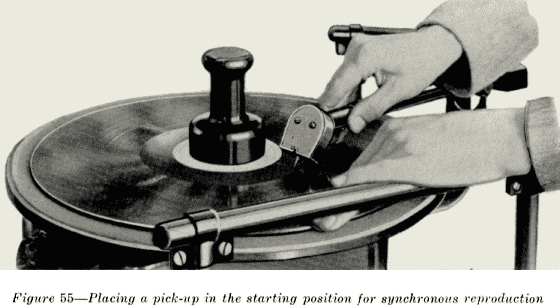75. Non-Synchronous Turntables. - The purpose of the non-synchronous turn table is to provide music in the absence of an orchestra, or during the showing of pictures for which no special sound accompaniment is provided. It also provides a method for playing overtures and exits. RCA Photophone has five types, four in steel cases. Three contain two 78 r.p.m. turntables and the other contains three turntables of the same speed. The phonograph with a wooden case contains two 78 r.p.m. turntables.
76. Types PT-4 and PT-5 Theatre Phonographs. - The Type PT-4 is built into a steel case and is equipped with two turntables. See Figure 56. Both turntables turn whenever the power switch is on, but either table can be easily stopped by simply pressing a finger against it until it comes to rest. This can be done without damage to the mechanism as each turntable is driven by a separate electric motor. If a turntable has been stopped to change a record, it will automatically start again so long as the switch is left on.

The pick-up lamps are used for illumination only. They are neither signal nor pilot lights except in so far as they are always burning when the power switch is turned on. The compartment lamp, likewise, is for illumination only. It operates from the switch directly in front of the lamp and it lights only when the power switch is on. The three signal lamps in the right-hand corner are controlled from the rear of the theatre. Signals may be arranged with someone stationed in the theatre at the signal lamp controls, for the proper monitoring of the volume.
To the right of the compartment lamp is a socket for inserting the plug of a monitoring speaker.
The two volume control knobs, control the volume of their respective pickups. The radio volume control would be used only if the amplifying equipment were used to amplify a radio program received upon an individual radio set. If it is desired to use the equipment for this purpose, connect the two output wires from the receiving set to the terminals marked "Radio" on the rear panel, and set the selector switch on the "Radio" position.
6
